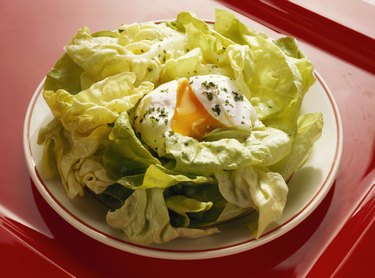Things You'll Need
Nonstick cooking spray
Pastry brush
Olive oil
Vegetable oil
Softened butter
Rubber spatula

Poached eggs are fragile — having a runny mess for breakfast isn't too appealing. Use a regular pan or a pan made especially for poaching eggs, which includes a set of cups that lie above simmering water; the hot water cooks the eggs to your desired consistency. The cups in poaching pans help keep the eggs separated, which helps when cooking a number of eggs at once. Because the eggs come into contact with the cups, keeping them from sticking is essential.
Step 1
Use a poaching pan with a nonstick surface, which poaching pans typically have. The nonstick surface helps ensure the eggs don't stick to the sides of the pan. However, even if the pan is nonstick, it still needs to be greased to ensure nothing sticks to it.
Video of the Day
Step 2
Spray each poaching cup with nonstick cooking spray, or brush some vegetable oil, olive oil or softened butter into each cup. Spread enough oil or butter into the cups to coat them evenly. Certain poaching pans have decorative cups that may have small grooves. Be sure to spread the oil or butter in the grooves, where the eggs may stick even more.
Step 3
Warm your poaching pan over medium heat before dropping your eggs into it. You want the water to be simmering before adding the eggs. Cook the eggs according to the pan's instructions.
Step 4
Gently slide a small rubber spatula around the bottom and sides of each poached egg when you're ready to serve them. This ensures that the egg doesn't stick to the sides of the poaching cups.
Video of the Day